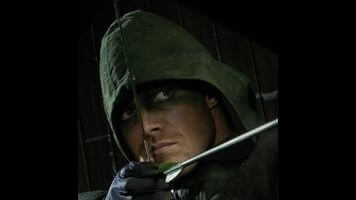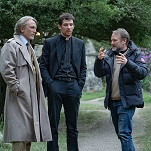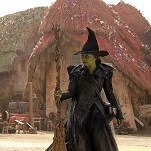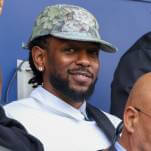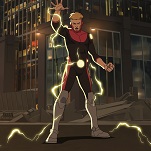Look, I think we can all agree that this has been a somewhat bumpy first half of the season for Arrow. The show has been a bit muddled in how it’s developed the mystery of Sara’s death, struggling to find the right balance between the villains of the week and the overarching narrative. The flashbacks have never really been a vital part of the show, but the show has appeared particularly uncertain about what it’s trying to convey with the Hong Kong stuff. And, honestly, The Flash probably hasn’t helped matters, both in diverting the attention of some members of the longstanding Arrow creative team and in providing such a lighthearted, often joyous counterpart to Arrow.
But seriously, forget about all that crap. Because my goodness, does this show know how to do an ending. I’d call it the ultimate cliffhanger, but I believe cliff-dropper would be the more accurate term.
Let’s circle back to that ending, because it would be a mistake to let that monopolize the discussion of “The Climb,” and that’s particularly true considering Oliver’s apparent (but assuredly not actual) death will be the defining subject of the show’s 2015 premiere. So let’s instead focus on how the show makes the journey to that big finale. So much of the episode’s success hinges on finding the right resolution to Sara’s murder, and only a fraction of that is about the specifics of who did it. The pool of narratively plausible suspects has always been small, because Arrow couldn’t really expect to reveal Sara’s killer as someone we’ve not met before; after all, what would be the impact of such a reveal? The fact that this is a comic book show would give Arrow a little latitude to reveal that her killer is some iconic supervillain that we’ve not met before, but—especially given that the one thing we knew about Sara’s murderer is that she recognized and apparently didn’t fear the person—it’s likelier that her killer is an established character, and probably a regular.
And, well, that’s a damn small list. You can safely eliminate Captain Detective Lance and Team Arrow members like Diggle, Felicity, Laurel, and Oliver—though the episode does manage at least a momentary fake-out when the DNA analysis reveals Oliver is the killer, if only because it’s too preposterous not to briefly entertain. There’s a reason the show spent an entire episode considering the possibility that Roy was the killer, because he’s still so thinly characterized that it’s conceivable that he could have done it, especially when you throw in the lingering effects of Mirakuru. But really, the only satisfying suspects are the Merlyns, and Malcolm is so ridiculously obvious a candidate that the show devoted another episode to eliminating him. Thea is the most compelling option, because the show does delight in torturing Oliver at every turn, and it’s hard to imagine a more horrendous possibility than that his sister killed the (well, a) woman he loved.
Reading the comments, I know Thea has been a frequent topic of speculation since Sara’s death, but I must admit I hadn’t seriously considered her a candidate, if only because Arrow didn’t appear to be laying down any clues pointing toward her; yes, Malcolm had gotten inside her head and twisted her, but she didn’t come across as a cold-blooded killer. “The Climb” ends up confirming that appraisal, revealing that Malcolm had induced hypnosis in her and effectively mind-controlled her into killing Sara, leaving her with no memory of her crime. That’s a convoluted reveal, but it fits with Arrow’s more operatic, larger-than-life storytelling style, particularly when we learn the information in the form of a floridly villainous John Barrowman monologue. It also allows the episode to position Oliver as something other than a complete idiot, as he appears hell-bent on making the precise same mistake he made with placing too much trust in his parents’ good intentions. Diggle is right to point out that Oliver’s greatest weakness is his blind spot with respect to his family, yet Oliver ends up being right that Thea isn’t lying to him about her role in Sara’s death.
What also makes the reveal work is the fact that it instantly shifts the emphasis away from the whodunit and onto the question of how Oliver will deal with the fallout of Malcolm’s gambit. A resolution that features Team Arrow getting vengeance for Sara’s murder could raise some thorny questions about Oliver’s insistence on the no-kill rule, but it would also be a little familiar, a little emotionally remote. This resolution instead recasts the issue so that Oliver must go fight Ra’s al Ghul to protect Thea and, in theory, get Malcolm off the hook for his own crimes against the League of Assassins. Again, this is the kind of devilishly complicated plots that likely wouldn’t work if Barrowman didn’t act so damn cool while revealing all of it; this is an absurdly byzantine way to get him free of the League—hell, the end of the episode suggests it didn’t even work—but this is just the right kind of crazy for Malcolm Merlyn. This is the guy who grieved his wife’s death by building a pair of earthquake machines, after all.
The attempt to tie together the Hong Kong flashbacks with the present-day scenes by revealing Maseo Yamashiro has since joined the League isn’t bad, and it does lightly foreshadow the tragedy that befalls his family at the hands of China White. I’m still not really sure where Arrow is trying to go with these flashbacks, beyond offering an ongoing contrast between Oliver’s present-day reform and his past transgressions, but the presence of Maseo does offer a sense of deeper personal history to the scenes with the League. Also, while Maseo is too morally compromised to call him a straight-up hero, his presence in the League does suggest it’s more ambiguously aligned than the fairly villainous depiction of Ra’s al Ghul up to this point might have us believe. The fact that people like Maseo and Sara could find a place here—albeit only after suffering unimaginable tragedy—suggests there’s a certain grim truth to Ra’s al Ghul’s pronouncement that the League replaces evil with death.
And then, again, there’s that ending. Arrow twists the blade here just as expertly as Ra’s does, first suggesting that Oliver is doing better than the average combatant, then letting him briefly appear to get the upper hand, and then revealing that, nope, Ra’s still far outstrips Oliver as a fighter. There’s not exactly an obvious way to extricate Oliver from this latest bit of peril, which means we’re looking at Team Arrow doing something fantastically clever to fake his death, or we’re looking at some bit of comics lore to resurrect him—looking at you, Lazarus Pits, and that possibility is at least somewhat increased by the fact that Ra’s claims he hasn’t been challenged to trial by combat in 67 years.
The choice here is the same as the one with the solution to Sara’s murder: The show can either draw upon the elements it has already established or use this franchise-shaking moment to introduce still more comics iconography. With Sara’s death, the show went with the former, and the result is a powerful, emotionally rich conclusion—or, at least, natural pause point—for what has been a fitfully successful plotline. It took a while for Arrow to understand what this story was about, but Oliver at least ends on moments of clarity: He will do anything to protect Thea, and he loves Felicity. Assuming he comes back from his own certain death, that’s plenty to build on in 2015.
Stray observations:
- Alex Kingston drops by as Laurel’s mom, sporting a particularly shaky American accent this time around. (Then again, I’ll admit it’s a pretty damn excellent approximation of what Paul Blackthorne does, so maybe the Lances just have their own unique take on the American accent.) It’s an interesting move to have Dinah so strongly sanction vengeance against Sara’s murderer, and I think we can officially start the countdown clock for the big Thea-Laurel confrontation.
- We’re inching closer to something actually happening with Ray Palmer other than him just being sort of generally creepy and charming, as he reveals he plans to retrofit Queen Consolidated’s OMAC plans as something he instead calls ATOM, the plan in both cases being to help law enforcement better protect the people of Starling City. Also, Ray mentions making things smaller, which I take as an encouraging sign.
- I like the way the episode handles the confrontation between the Arrow and Thea: Oliver is clearly taken aback by Thea’s ability to fight back, but there’s no sense that she’s actually capable of holding her own in a fight once the element of surprise is gone. This is a recurring pattern this year, as Arrow has been fairly consistent about establishing that the vast majority of foes—anyone other than Malcolm and Ra’s, basically—cannot match Oliver for strength or fighting prowess, and it’s only his own hesitancy or unwillingness to kill that holds him back.
